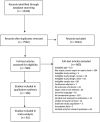Criteria for Pediatric Sepsis-A Systematic Review and Meta-Analysis by the Pediatric Sepsis Definition Taskforce
- PMID: 34612847
- PMCID: PMC8670345
- DOI: 10.1097/CCM.0000000000005294
Criteria for Pediatric Sepsis-A Systematic Review and Meta-Analysis by the Pediatric Sepsis Definition Taskforce
Abstract
Objective: To determine the associations of demographic, clinical, laboratory, organ dysfunction, and illness severity variable values with: 1) sepsis, severe sepsis, or septic shock in children with infection and 2) multiple organ dysfunction or death in children with sepsis, severe sepsis, or septic shock.
Data sources: MEDLINE, Embase, and the Cochrane Central Register of Controlled Trials were searched from January 1, 2004, and November 16, 2020.
Study selection: Case-control studies, cohort studies, and randomized controlled trials in children greater than or equal to 37-week-old postconception to 18 years with suspected or confirmed infection, which included the terms "sepsis," "septicemia," or "septic shock" in the title or abstract.
Data extraction: Study characteristics, patient demographics, clinical signs or interventions, laboratory values, organ dysfunction measures, and illness severity scores were extracted from eligible articles. Random-effects meta-analysis was performed.
Data synthesis: One hundred and six studies met eligibility criteria of which 81 were included in the meta-analysis. Sixteen studies (9,629 patients) provided data for the sepsis, severe sepsis, or septic shock outcome and 71 studies (154,674 patients) for the mortality outcome. In children with infection, decreased level of consciousness and higher Pediatric Risk of Mortality scores were associated with sepsis/severe sepsis. In children with sepsis/severe sepsis/septic shock, chronic conditions, oncologic diagnosis, use of vasoactive/inotropic agents, mechanical ventilation, serum lactate, platelet count, fibrinogen, procalcitonin, multi-organ dysfunction syndrome, Pediatric Logistic Organ Dysfunction score, Pediatric Index of Mortality-3, and Pediatric Risk of Mortality score each demonstrated significant and consistent associations with mortality. Pooled mortality rates varied among high-, upper middle-, and lower middle-income countries for patients with sepsis, severe sepsis, and septic shock (p < 0.0001).
Conclusions: Strong associations of several markers of organ dysfunction with the outcomes of interest among infected and septic children support their inclusion in the data validation phase of the Pediatric Sepsis Definition Taskforce.
Copyright © 2021 The Author(s). Published by Wolters Kluwer Health, Inc. on behalf of the Society of Critical Care Medicine and Wolters Kluwer Health, Inc.
Conflict of interest statement
Dr. Menon has a Canadian Institutes of Health Research grant for the study of corticosteroids in pediatric septic shock. Dr. Menon’s institution received funding from Crowdsourcing; he disclosed that he is a principal investigator on an international trial on Steroids in Pediatric Sepsis Shock. Drs. Menon and Watson received funding from Society of Critical Care Medicine. Dr. Argent received funding from the World Federation of Pediatric Intensive and Critical Care Societies as a part of the process of working with the Pediatric Sepsis Definitions working group. Dr. Biban received funding from Chiesi and Getinge. Dr. Nadel received funding from Abbvie. Dr. Sadeghirad received funding from the Pre-Interventional Preventative Risk Assessment AG, Mitacs Canada, and Accelerate internship in partnership with Nestlé Canada. Dr. Scott’s institution received funding from the Agency for Healthcare Research and Quality (AHRQ K08HS025696); he received support for article research from the AHRQ. Dr. Tissieres received funding from Sedana, Inotrem, and Baxter. Dr. Wynn received funding from the National Institutes of Health (NIH) (R01GM128452; R01HD089939, R01HD097081, R43EB029863). Dr. Zimmerman’s institution received funding from the NIH, the National Institute of Child Health and Human Development, and Immunexpress; he received funding from Elsevier Publishing. The remaining authors have disclosed that they do not have any potential conflicts of interest.
Figures


Comment in
-
Sepsis Definitions: I Know It When I See It.Crit Care Med. 2022 Jan 1;50(1):148-150. doi: 10.1097/CCM.0000000000005350. Crit Care Med. 2022. PMID: 34914644 No abstract available.
References
-
- Goldstein B, Giroir B, Randolph A; International Consensus Conference on Pediatric Sepsis. International pediatric sepsis consensus conference: Definitions for sepsis and organ dysfunction in pediatrics. Pediatr Crit Care Med. 2005; 6:2–8 - PubMed
-
- Weiss SL, Peters MJ, Alhazzani W, et al. . Surviving sepsis campaign international guidelines for the management of septic shock and sepsis-associated organ dysfunction in children. Pediatr Crit Care Med. 2020; 21:e52–e106 - PubMed
Publication types
MeSH terms
Grants and funding
LinkOut - more resources
Full Text Sources
Medical
Miscellaneous

